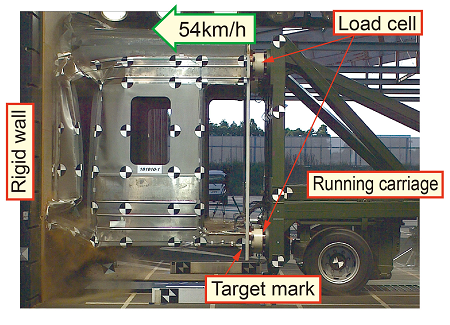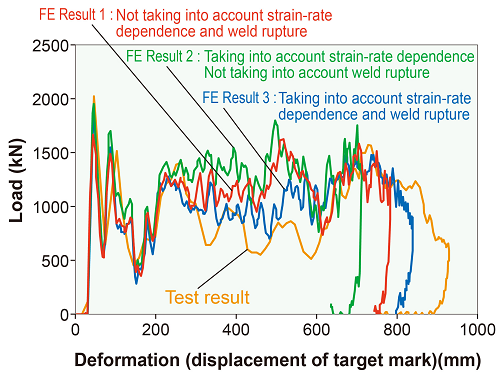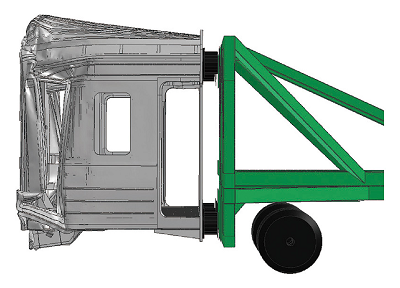26. Head car collision testing and numerical simulation
When investigating measures to reduce injuries to passengers and railway staff in the case of a collision accident, tests involving full-scale trainsets are difficult to conduct because of large scale, and so numerical simulation is an effective alternative, but if simulation is used, then accuracy is essential.
Therefore, in order to increase the precision of simulation, a crash test was conducted on a full-scale partial vehicle structure. The test vehicle was cut out from a stainless steel used head car carbody. A special running carriage was built to mount the test vehicle, and a high energy crash test was carried out. The test vehicle collided with a rigid wall at a speed of 54km/h. This speed was established on the basis of a statistical analysis of past serious level crossing accidents in Japan. The results of the test were used to quantitatively investigate the crash behavior of the carbody structure, such as deformation and fracture of the main structural elements (center and side sill, etc.), as well as the crash load/deformation characteristics (Figs. 1 and 2).
A comparison of results from an FEM analysis using the same conditions as in the crash test with the actual test results showed that by reflecting various material properties, i.e. strain-rate dependence obtained from tensile tests carried out at various speeds, and spot and arc weld rupture characteristics etc., in the FEM model, it was possible to reproduce the carbody’s deformation behavior and load/deformation characteristics with high accuracy.
As a result, the maximum load error was approximately 12%, and the maximum deformation error was approximately 10% (Figs. 2 and 3).
This method therefore makes it possible to examine the various types of crash behavior of carbody structures that occur in a collision accident.
Other Contents
- 26. Head car collision testing and numerical simulation
- 27. Snow accretion simulation method for high speed trains
- 28. Ground-to-train communication system using 90 GHz band millimeter-wave
- 29. Mechanisms underlying slope collapse due to rain or during an earthquake resulting from changes in water content of volcanic soil
- 30. Factors influencing concrete deterioration due to expansion
- 26. Head car collision testing and numerical simulation
- 27. Snow accretion simulation method for high speed trains
- 28. Ground-to-train communication system using 90 GHz band millimeter-wave
- 29. Mechanisms underlying slope collapse due to rain or during an earthquake resulting from changes in water content of volcanic soil
- 30. Factors influencing concrete deterioration due to expansion



